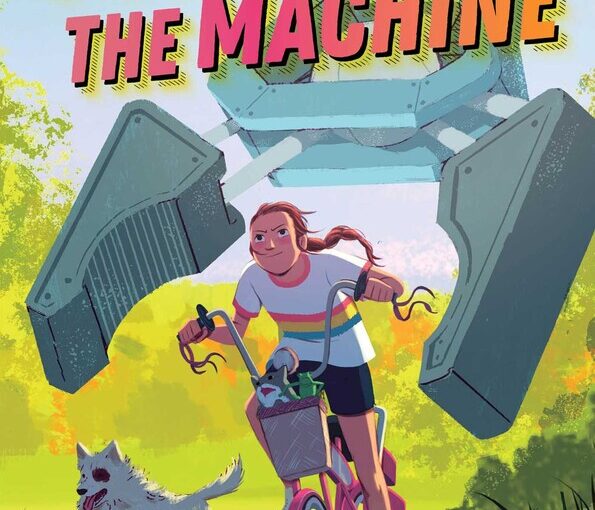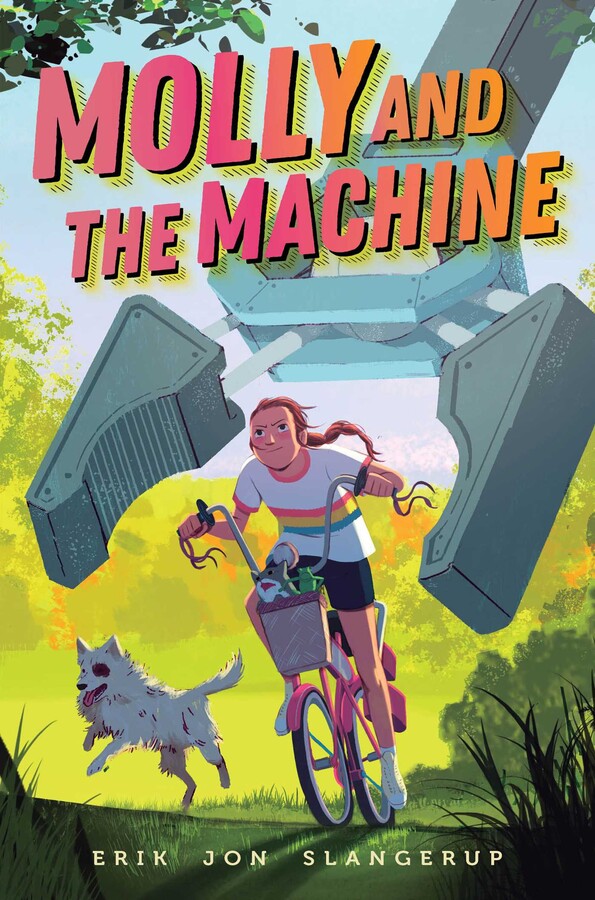Mglit does not have to be based in the 80s to be entertaining. I say that because it seems that a couple of the books that we’ve read recently have had ties to that fabulous decade. Certainly, a major reason for that is the absence of screens. There’s no device that kids have to occupy them, solve their problems, do their research or look at pictures of giant robot footprints. That’s what Molly from Molly and the Machine might’ve done when she first started her adventures. It’s an mglit book that takes off its shoes and wades knee-deep in the river of fun reading. This is also an example of mglit that skews younger, allowing ages eight and up the chance to enjoy the adventure.
To those legitimate middle school readers who are that age, do not mistake the fact that Molly and the Machine can be enjoyed by your elementary school brethren, for the fact that it’s not entertaining for you. Au contraire, it’s akin to much in the way that an all-age comic book is ‘all-age’ simply due to its lack of gratuitous situations. Molly and the Machine harken back to a feel-good era when kids didn’t need a screen to be entertained. Yeah, it was uphill both ways, in the snow, and the wind always blew in our faces regardless of which direction we faced.
You middle school readers know that I was exaggerating there, don’t you? Old people will talk about the ‘good ole days’ in a way to bring back fond memories of their childhood. However, just because an mglit book doesn’t take place in modern times does not automatically mean that you’ll want to tune it out. Sometimes, simpler is better, especially when it comes to pleasure reading. Whether you acknowledge it or not, your brain wants to think, feel around the dark areas, and not have everything explained to it, or you.
Molly and the Machine is fiction that’s honed in on those readers aged eight and up who crave that. In some mglit cases, it’s a stretch to say that third or fourth graders can read it. In this case, those fourth graders will certainly be able to read it, and those late-third graders will probably be able to read it. The chapters range from five to 12 pages in length and the font size is bigger than most mglit books. That font size is welcoming to those younger readers because it’s less intimidating, as well as, those middle-aged parents who need to go see the optometrist.
You middle school readers think that because the font is larger than you’re used to and that the chapters are welcoming to younger readers that this is too much of a baby book, don’t you? That’s what you’ll say aloud when your friends are around. However, if you’re reading the book then you’ll simply see it as a chance to relax and jump into a great book.
The pacing of Molly and the Machine is perfect for those ages too. The first chapter opens with the machine making its first appearance. This is important because some readers might think that the machine is a metaphor or that it’s only around for half of the book. We meet Molly, her dad who doesn’t seem to care too much about her, Wally-the annoying brother, the local middle school jerks, and her uncle. All of these characters come into play to some degree during the course of the book.
The siblings get along as well as any sometimes feuding brothering and sister do, which exacerbates Molly’s feeling of guilt when she sees the machine eat her brother. But, is it fear because she’ll get in trouble with her dad that a robot at her brother, or an actual case of her missing him? This sets the course for the rest of the book as she rides her bicycle, which is a character in its own right, through the woods in an effort to catch up with this 40’ robot. This allows the reader’s imagination to go down the rabbit hole-is the robot really that big, is it from another world, how is it that this machine is not big news in her small town and so many more questions that you’ll logically ask.
Molly and the Machine is that laid-back friend that you’re not expecting much from but completely surprises you as to how much fun you have with them. While I don’t know if it’s part of a series, Far Flung Falls #1 is on the spine of the book. If it were to become a series or an anthology that had the same vibe it’s a trip that many mid-elementary readers and up would welcome.
Molly and the Machine is by Erik Jon Slangerup and available on Aladdin, an imprint of Simon & Schuster.
There are affiliate links in this post.






 Facebook
Facebook Twitter
Twitter Flickr
Flickr GooglePlus
GooglePlus Youtube
Youtube